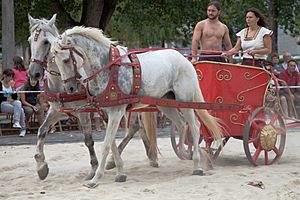Chariot facts for kids
A chariot is a type of vehicle pulled by horses. A driver, called a charioteer, stands in it. Chariots were very fast for their time. People used them for many things. They were used in armies for transport or for archers to shoot arrows from. People also used them for hunting, racing, and simply to travel quickly in ancient times.
The word "chariot" comes from the Latin word carrus. This word itself came from an older Gaulish word. In ancient Rome and other ancient Mediterranean civilizations, chariots had different names based on how many horses pulled them. A biga used two horses. A triga used three. A quadriga was pulled by four horses.
Chariots were light, open vehicles with two wheels. They were pulled by two or more horses side by side. The chariot itself was mostly a floor with a waist-high guard at the front and sides.
Chariots in History
Chariots were first used for ancient warfare during the Bronze and Iron Ages. They were important tools for armies. Over time, horses were bred to be bigger and stronger. This made cavalry (soldiers riding horses) more effective. Because of this, chariots were used less for fighting.
After their military use changed, chariots became popular for other activities. People used them for travel and in processions. They were also used for games and exciting races.
Chariots in Myths
Ancient Greek myths tell a story about how the chariot was created. They say that Poseidon, the god of the sea, and Athena, the goddess of wisdom, worked together. Poseidon created the horses, which moved like waves. Athena then made the chariot itself. This shows how important chariots were even in ancient stories.
Images for kids
-
Han dynasty bronze models of cavalry and chariots
-
The area of the spoke-wheeled chariot finds within the Sintashta-Petrovka Proto-Indo-Iranian culture is indicated in purple.
-
Chariot detail at Airavatesvara Temple built by Rajaraja Chola II of the Chola Empire in the 12th century CE.
-
Stone chariot at Hampi, built under the Vijayanagara Empire, early 16th century CE.
-
A golden chariot made during Achaemenid Empire (550–330 BCE).
-
Ramses II fighting from a chariot at the Battle of Kadesh with two archers, one with the reins tied around the waist to free both hands (relief from Abu Simbel)
-
The Charioteer of Delphi was dedicated to the god Apollo in 474 BCE by the tyrant of Gela in commemoration of a Pythian racing victory at Delphi.
-
Two female charioteers from Tiryns 1200 BCE
-
A petroglyph in a double burial, c. 1000 BCE (the Nordic Bronze Age)
-
A winner of a Roman chariot race
-
A mosaic of the Kasta Tomb in Amphipolis depicting the abduction of Persephone by Pluto, 4th century BCE.
-
The goddess Nike riding on a two-horse chariot, from an Apulian patera (tray), Magna Graecia, 4th century BCE.
-
Procession of chariots on a Late Geometric amphora from Athens (c. 720–700 BCE).
-
Sculpture by Thomas Thornycroft of Boudica and her daughters in her chariot, addressing her troops before the battle.
-
Procession of chariots and warriors on the Vix krater (c. 510), a vessel of Archaic Greek workmanship found in a Gallic burial.
-
Modern reconstruction of a Hussite war wagon.
-
Chariot burial of Zheng
-
Bronze Chinese charioteer from the Warring States period (403–221 BCE).
-
Powerful landlord in chariot (Eastern Han, 25–220 CE, Anping County, Hebei).
See also
 In Spanish: Carro de guerra para niños
In Spanish: Carro de guerra para niños



























